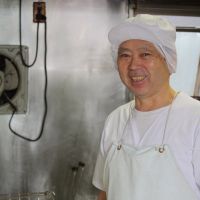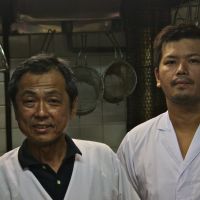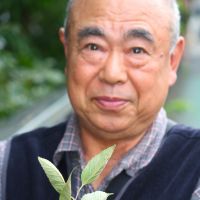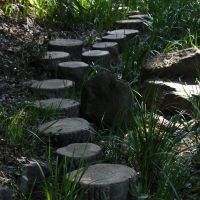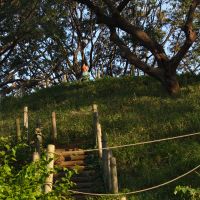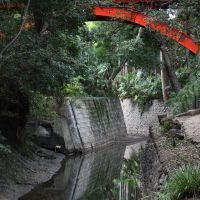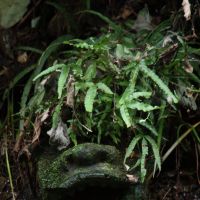Todoroki Valley Park, a protected green swath along Tokyo's only ravine, strikes me as an interesting and possibly quite sheltered destination on a brisk and breezy fall day.
An Oimachi Line local train lets me off at Todoroki in southwestern Setagaya Ward, a no-frills station level with the tracks and between bamboo crossing gates. As I head out into the midday sun, the neighborhood at once appears quaintly low-rise. Passing a crepe stand and takeout sushi shop reminds me that there might be no restaurants in the Todoroki Keikoku ravine. Good to gorge before going, I think.
So, in search of a quick bite I part the sagari fujii (hanging wisteria) noren (entry curtain) at Yabumori Soba — only to find the place packed. But curious as to why, I order its best tempura soba (¥1,400) and wait. My bowl arrives filled with hand-cut buckwheat noodles undulating below a heap of crispy shrimp, vegetables, sea eel and squid, and the broth has the pungent kick of fresh bonita. Hence the throng, I think, tucking in.
"My grandfather's shop opened in 1923," Hirokazu Hayakawa, the 62-year-old owner, tells me. "And my son, Fumiyoshi, is our family's fourth-generation soba-maker."
I watch Fumiyoshi, 35, move effortlessly in the kitchen, while his wife, a beaming beauty, sets out green tea for me and her father-in-law.
The lunch rush nearly over, Hirokazu Sr.recounts how his family's former two-story wooden soba shop once stood conspicuous amid agricultural fields. "My grandfather was born here, and I grew up playing in the Todoroki ravine," he says.
"We used to dig up crabs and snakes — but that was when the river had a natural bottom, not concrete. There were also caves constructed to protect people from bombs during World War II, but they're filled in now. From the ancient tombs nearby, we sometimes unearthed old shards of pottery, and that was exciting."
He kindly offers me a valley map, marked with its sights. I thank the Hayakawa family and head toward the river. En route, I peek into Zaimokuya, a Chinese restaurant occupying a 120-year-old Japanese-style home. According to a gardener snipping trees outside, the building was originally owned by the Suzuki family, wealthy local lumber merchants since the distant days of the Kamakura Shogunate (1192-1333). Cool place to eat 100-year-old duck eggs, I think.
At the edge of the ravine, I peek into Midoriya, an elegant tofu shop, and meet its owner, Haruhiko Iwata. "I'm just learning this business," the second-generation tofu-maker says. "I want to reach the ceiling of know-how, and then burst through it. But, I'm still just a tofu boy." A regular customer laughs at this. "A 65-year-old boy?" she chides. Iwata shrugs.
Midoriya's cases are full of tofu treats: sweet puddings, wooden boxes of scooped (rather than molded) yose-dofu, trays of yuba (tofu skin) and tofu made from both green and yellow soybeans. Iwata allows me behind the scenes, where fresh flats of silken tofu are sliced delicately and set adrift in water. Iwata checks the pucker on a sheet of yuba, then deftly lifts the skin on a dowel.
Following "Tofu Boy," I climb slippery stairs to the abura-age (fried bean curd) production area. There, the fry chief fires an air gun into each piece of golden tofu. "If it doesn't inflate, you can't stuff it with rice," Iwata explains. He flips a hot dud onto a plate, adds a blip of soy sauce, and offers it to me. My crispy sample may not hold air, but it tastes divine.
Now inflated myself, I thank Iwata, and descend into the valley. A stand of giant Moso bamboo, the largest there is outside the Tropics, sighs loftily overhead in a breeze, and Brown-eared Bulbuls shriek in the canopy of oak and hornbeam trees. Winged seedpods spin through sun shafts piercing the frieze of boughs overarching the Yazawa River. It astonishes me how the noise of the city and its traffic are obliterated once I'm in the ravine.
Todoroki Valley Park has clearly been designed to lead the senses. The 1.2-km-long path features numerous surfacings — concrete slabs, wooden slats, stepping stones and stretches with or without protruding rocks — while both the bridges spanning the river and those busy with traffic overhead also vary in style and color. Even the treatment of water — at times an unobstructed still flow, at others broken by partial dams, miniature falls or strategically placed rocks — provides entertainment in differing surface patterns and burbling sounds.
Along the way, paths fork upward into dazzling light. One, a series of precarious log steps, ends at Otto, an Italian restaurant perched on the valley rim at the crossing of Kanpachi-dori. While the brick pizza oven and treetop vistas are enticing, I merely note the location for another time and hike back down into the ravine. Before long, a slightly spookier path of dark, stone steps leads me to one of valley's three 7th- to 8th-century kofun (cave tumuli). This tomb, Yokoana Kofun, has a glass viewing panel at the small stone entrance hole, but sadly it was too dark to see inside.
Brushing off spider webs, I continue downriver, then wend along another trail that culminates at Chigo Daishi Mieido, a sculpted image of priest Kobo Daishi (774-835) as a slightly effeminate child.
The priest, founder of the Shingon sect of Buddhism in Japan, apparently had a vision that inspired him to explore this valley, where he discovered its spring waters. At the nearby spring-fed tsukubai (stone washing basin), a local man fills containers from a bamboo pipe branching from the same water source. Is the water potable? He points to a sign that recommends boiling before consuming. "I drink it all the time," he says.
At the Fudo no Taki waterfall across the river, two small streams of groundwater issue from dragons' mouths emerging from the ravine's side. Fellow hikers explain that the water once gushed so powerfully that Shugendo spiritual ascetics would sit below, bearing the pain of the cold torrent as part of their spiritual training. I recall that soba shop owner Hayakawa showed me a photo of this, taken back when the falls produced what he called "a real todoroki (sound of roaring water)."
I climb to the Todoroki Fudo, a Buddhist temple directly above the falls. At the top, I gaze at length over this Setagaya power spot before descending once again to the river along mossy and wickedly slippery paths past a Benten shrine and a lonely jizo statue.
I sense the end of the valley walk approaching. Before I run out of greenery, though, I infiltrate a small group climbing steps through what appears to be someone's private garden. We pass citrus trees heavy with fruit, and classic Japanese garden features such as a karasansui (dry water feature in rocks) and stone lanterns. At the ridgetop, a chashitsu (tea house) awaits. My new friends inform me that this is a public park. We help ourselves to tea, paid for on the honor system, and chat.
I discover that one in the group, Yasuhiro Arima, lives nearby. I prevail upon him to help me locate, behind several public housing projects, Noge Otsuka Kofun, a 5th-century burial mound. There, I join a pod of kindergarteners at the summit of the grassy hillock that has yielded bones, swords and pottery from ancient times.
Daylight dims, so I decide to return home along regular highroads. As I am crossing Kanpachi-dori in the twilight, I see a man leaning over the bridge and snagging branches from one of the valley's trees. Curious, I ask what he is doing.
"Ah, I bet you have never tried one of these," he says, plucking things from a branch and handing me what look like blueberries, slightly wrinkled. I'm stumped. "They're muku (Aphanathe aspera; muku tree) berries," Seiichi Watanabe, 71, informs me.
I try one, and the flavor is half lychee, half raisin. Watanabe is clearly pleased I have trusted him, and I am thrilled at tasting a new fruit. Talking together about trees, we reenter the dark valley, where I feel that goodness will follow us for the rest of the day.
"Tokyo Stories," an exhibition of artistic photographic works by Kit Nagamura and Joji Shimamoto, will be held from Nov. 14-Dec. 22 at the Tobin Ohashi Gallery, Yokoyama-cho 1-4, Nihonbashi, Tokyo, a 1-min. walk from Bakuro-Yokoyama Station on the Shinjuku Line; (03) 5695-6600 / 080-3252-7782; admission free. Readers of The Japan Times are invited to the opening party from 3 p.m.-8 p.m. on Nov. 13.



